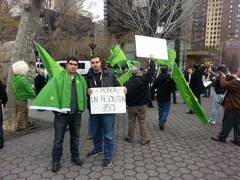Circassians Become Targets in Syria; Activists Seek International Help
The village of Beer Ajam had a population of 400 people and Bariqa about 500 people. However, after the conflict in Syria intensified, many Circassians from Homs and Damascus chose to move there, since the area was considered to be one of the safest in the country. So the populations of these villages swelled as Circassian refugees moved in. On November 2, Syrian opposition forces reportedly also moved into the area, and the Syrian government started to shell the two villages indiscriminately. So the Syrian Circassian civilians became hostages to the fighting between the opposition and government forces. On November 5, a group of Circassian activists decided to try and evacuate the civilians in minivans. The group had reached an agreement with both the opposition forces and the Syrian army to provide safe passage for the evacuees. However, at the last minute, the army commanders changed their mind. Chilar Kat, a Circassian from the Israeli side of the Golan Heights, told Ekho Kavkaza radio that there was a second attempt to evacuate the civilians from the Circassian villages with the intercession of the Red Crescent and UN forces. However, when four buses and an ambulance approached the villages, shelling started again and the attempt to save the civilians failed. At least six residents of the Circassian villages reportedly died in the shelling (http://www.ekhokavkaza.com/content/article/24765499.html).
Circassians have lobbied the Russian authorities for months to organize the evacuation of the Syrian Circassians. No more than 1,000 Circassians from Syria were allowed into Russia on temporary visas. When the visa quotas were exhausted, Russian authorities did nothing to supply additional quotas. Moscow avoided taking any resolute steps in either promoting Circassian immigration to the North Caucasus or clearly stating it will not accept more than a certain number of Circassians.
The irony of the situation is in the fact that the Golan Heights are part of the demilitarized zone. On May 31 1974, following the 1973 Yom Kippur War, the United Nations Security Council adopted Resolution 350. The United Nations Disengagement Observer Force was established to monitor the ceasefire between Israel and Syria in the wake of the war. UNDOF was initially established for a period of six months, but has had its mandate renewed by subsequent resolutions. So the current spike of violence appears to constitute a clear violation of the UN resolution (http://www.ekhokavkaza.com/content/article/24765499.html). On November 11, Israeli forces opened fire in response to earlier isolated shelling and shooting incidents on the Golan Heights. The limited armed response by Israel in the area with UN observers was reportedly the first of its kind since the 1973 war (http://www.newsru.co.il/mideast/11nov2012/golan_120.html).
On November 8, the Circassian activist Tamerlan Urusov staged a one-man protest in front of the Russian Foreign Ministry building in Moscow, demanding the evacuation of the Syrian Circassians to Russia. The 28-year-old activist told the Kavkazsky Uzel (Caucasian Knot) website that he used to be politically indifferent, but started to engage in Circassian activism in May 2012. Urusov told the website: “I think this protest event might be harmful to me personally. It is hard to know what the reaction of our security services will be, given their suspicious attitude toward civil activism. I am confused and a bit alarmed, but I am not scared anymore—if [I] remain silent, it will be even worse” (http://www.kavkaz-uzel.ru/articles/215419/). The Circassian activist’s personal story illuminates how people in the North Caucasus and elsewhere in Russia are rediscovering their civil rights and trying to make a difference through peaceful nonviolent protest.

